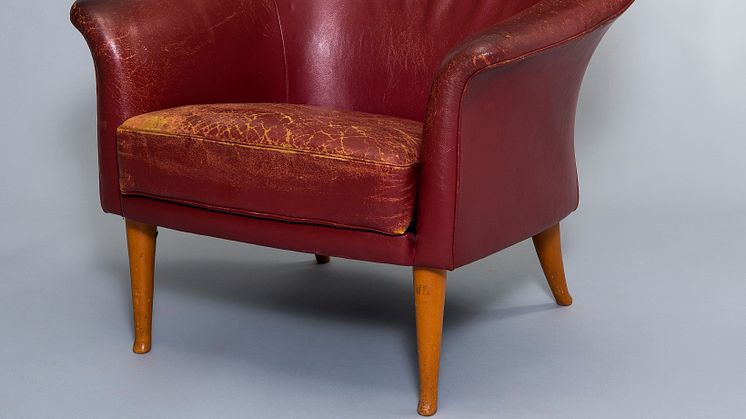
Press release -
New acquisition: Onkel Adam armchair by Kerstin Hörlin-Holmquist
Nationalmuseum has acquired an Onkel Adam armchair, a classic design by Kerstin Hörlin-Holmquist, who made her name as a furniture and textile designer for Nordiska Kompaniet and other brands in the 1950s and 60s. Nationalmuseum did not acquire any of her works until 2000, but now another of her more significant creations has joined the museum’s collection.
New materials revolutionised furniture design in the 1950s, when it became possible to create organic forms at relatively low cost in moulded plastic and soft foam rubber. The designer Kerstin Hörlin-Holmquist (1925–1997) took advantage of this new technique in her Paradiset series of furniture for Nordiska Kompaniet (NK), launched in 1958.
Hörlin-Holmquist graduated in 1952 from Konstfack in Stockholm with a degree in furniture design. After finishing her studies she set up her own business. While still a student, she had designed the Stora Kraal and Lilla Kraal armchairs, which featured in a major furniture exhibition at the Röhsska Museum, Gothenburg, in 1952. Inspired by traditional African furnishings, these wicker chairs were produced using a mix of mass manufacturing methods and craft techniques. Stora Kraal has been part of the Nationalmuseum collection since 2000.
The Kraal chairs were put into production by NK as part of the department store’s groundbreaking Triva range. This was the brand for which, in 1943, Elias Svedberg had designed a chair that came in a flat package for customers to assemble at home. Ikea, now synonymous with flat-pack furniture, did not enter the furniture business until 1952.
Hörlin-Holmquist’s best-known series of furniture, Paradiset, was also part of NK’s Triva range. The series comprised the Liten Eva, Stor Eva, Liten Adam, Stor Adam and Onkel Adam armchairs, the Lilla Paradiset sofa, the Lustgården chaise longue, and the Fikonlövet footstool. The pieces were fairly disparate in their design, with a variety of backrest, frame and armrest styles, but the soft, rounded forms and decoratively positioned upholstered buttons showed they were all related – like a family whose members are all individuals but have certain features in common. The Onkel Adam chair acquired by Nationalmuseum, with its unusual burgundy leather upholstery, was not fitted with the buttons when it was made at NK’s workshop in Nyköping in 1965.
Hörlin-Holmquist designed furniture and home textiles for NK from 1952 to 1964. She later worked with other companies such as OPE-möbler, for which she designed the Skrindan armchair.
Nationalmuseum was able to purchase the Onkel Adam armchair thanks to a generous bequest from Ulla and Gunnar Trygg. Nationalmuseum has no budget of its own for new acquisitions, but relies on gifting and financial support from private funds and foundations to enhance its collections of fine art and craft.
Media Contacts
Cilla Robach, Curator, Applied Art and Design: cilla.robach@nationalmuseum.se,+46 8 5195 4305
Nationalmuseum Press Office: press@nationalmuseum.se, +46 767 23 46 32
Categories
Nationalmuseum is Sweden’s premier museum of art and design. The collections comprise older paintings, sculpture, drawings and graphic art, and applied art and design up to the present day. The museum building is currently under renovation and scheduled to open again in 2018. In the meantime, the museum will continue its activities through collaborations both in Sweden and abroad as well as temporary exhibitions at Nationalmuseum Design at Kulturhuset Stadsteatern in Stockholm. Nationalmuseum has partnerships with Svenska Dagbladet and the Grand Hôtel Stockholm, and acknowledges the support of FCB Fältman & Malmén.

